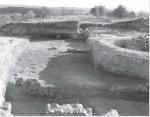Summary (English)
EXPLORATIONS IN ABRITUS (Galena Radoslavova – galena_rz@abv.bg, Georgi Dzanev) The explorations in the area between the eastern wall of the basilica and the eastern fortification wall continued. A stratum containing Late Antique and Early Mediaeval pottery was explored at 1.30 – 1.70 m in depth. Three Early Mediaeval sunken-floored houses (Nos. 11, 12 and 13) were discovered. The finds include sherds, animal bones, a lead weight, three iron arrowheads, a whetstone, a small bone spoon, a bone awl, an iron fire striker, a bronze finger-ring, an iron buckle, a bronze belt-chape, a bronze belt-appliqué, a silver cross (Encolpion), a copper pendant, a bronze bead and a glass bead. A stratum with debris was explored at 1.70 – 2.50 m in depth. It contained fragmentary burned mud-bricks, uneven stones, fragmentary tegulae and imbrices, iron nails, sherds and c. 90 bronze coins of the 4th – first half of the 5th centuries AD that originated from the earlier house situated in the lower level. A floor level of mortar was discovered at 2.50 m in depth and under the stratum of debris. Debris of a Late Antique house with walls 50 cm in width are situated under the floor level of mortar. The finds include sherds, a bronze fibula of the 4th – first half of the 5th century AD, and 22 bronze coins minted by Constantine I, Constantius II, Valens, Theodosius I, Arcadius and Theodosius II. The building was demolished in the middle of the 5th century AD. The first, early level of the basilica is situated over the debris from the building. There was an adjacent ramshackle room to the east from the apse of the early basilica. The finds include fragmentary marble tiles and columns from the altar fence of the basilica, two elements of a polycandelarium and fragmentary glass church-lamps. The spolia include two fragmentary altars, a fragmentary inscription from the Early Roman period containing the name of the town: Abritus, and a fragment from a votive relief of Zeus and Hera.
- Galena Radoslavova - Regional Museum of History – Razgrad
- Georgi Dzanev - Regional Museum of History – Razgrad
Director
Team
Research Body
- Regional Museum of History – Razgrad






![Download [PDF]](/excavation/skins/fasti/images/results/download_sml.png)